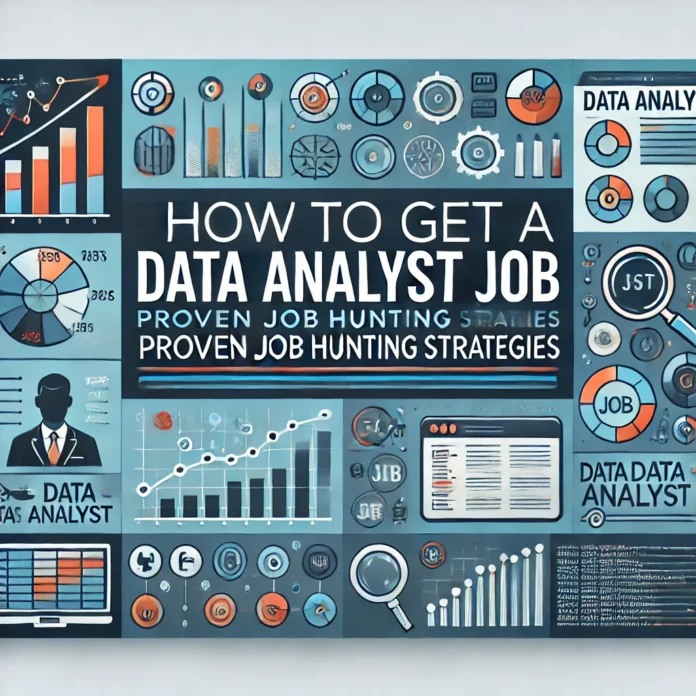The demand for data analysts continues to rise as businesses increasingly rely on data-driven insights. However, landing a job as a data analyst can be competitive. In this article, we’ll explore proven strategies to enhance your job hunting efforts and get you closer to your dream role as a data analyst.
1. Build a Strong Foundation in Data Analytics Skills
The first step to securing a data analyst job is mastering the core skills that employers are looking for. These include:
- Data Analysis Tools: Proficiency in Excel, SQL, Python, and R is crucial. Familiarity with BI tools like Power BI or Tableau is a plus.
- Statistics and Data Visualization: Understanding basic statistical concepts and being able to visualize data effectively are key competencies.
- Problem-Solving and Analytical Thinking: Employers seek candidates who can break down complex problems and derive actionable insights from data.
Take courses, earn certifications, and practice by working on real-world projects to sharpen these skills. Dicecamp offers one of the best training program with proven track record of job placements.
2. Build a Portfolio with Real Projects
A solid portfolio is your ticket to showcasing your capabilities. Work on personal projects, contribute to open-source projects, or complete data analysis case studies. Some examples of impactful portfolio pieces include:
- Data Cleaning and Wrangling Projects: Show how you handled messy datasets and extracted useful insights.
- Business Problem Analysis: Provide examples of how you solved business problems using data.
- Visual Dashboards: Share interactive dashboards you created using tools like Tableau, Power BI, or Google Data Studio.
A well-structured portfolio not only demonstrates your technical skills but also highlights your problem-solving approach.
3. Tailor Your Resume for Data Analyst Roles
Your resume is often your first impression with hiring managers, so it needs to be sharp and targeted. Key tips include:
- Highlight Relevant Skills: Emphasize data analysis, technical skills, and any experience with data tools.
- Quantify Achievements: Use numbers to show your impact, such as “improved data processing time by 30%” or “increased reporting efficiency by automating workflows.”
- Use Keywords: Tailor your resume with relevant keywords from job descriptions to pass through Applicant Tracking Systems (ATS).
Make sure your resume is clear, concise, and focused on the value you can bring as a data analyst.
4. Leverage LinkedIn for Networking and Job Search
LinkedIn is a powerful platform for finding data analyst opportunities and building connections in the industry. Here’s how to make the most of it:
- Optimize Your Profile: Make sure your headline reflects your expertise (e.g., “Aspiring Data Analyst | Proficient in SQL, Python, and Data Visualization”). Highlight relevant skills and experience in your profile.
- Engage with Industry Content: Share your insights, comment on data-related posts, and showcase your portfolio projects.
- Connect with Industry Professionals: Build relationships with hiring managers, data scientists, and other data analysts. Personalized connection requests and engaging with their content can open doors to opportunities.
- Set Job Alerts: Use LinkedIn’s job alert feature to stay updated on data analyst openings that match your preferences.
5. Ace Your Interviews by Preparing Thoroughly
Once you’ve secured interviews, preparation is key to success. Here’s how to stand out:
- Understand the Role: Research the company’s data needs and tailor your responses to how you can contribute.
- Brush Up on Technical Questions: Be prepared for SQL queries, statistical concepts, and Python coding challenges. Practice using platforms like LeetCode and HackerRank.
- Showcase Problem-Solving Skills: Be ready to walk through how you approach data analysis, from understanding business requirements to delivering actionable insights.
- Ask Insightful Questions: Demonstrate your interest and curiosity about the role by asking questions about the company’s data strategy, tools, and team culture.
6. Apply Consistently and Strategically
Persistence and focus are essential in job hunting. Create a structured plan that involves:
- Setting Daily or Weekly Application Goals: Dedicate time to applying for roles consistently.
- Targeting Companies of Interest: Research companies that are actively hiring data analysts and reach out directly if possible.
- Diversifying Your Job Search: Look beyond job boards—consider networking events, job fairs, and data analytics communities.
7. Stay Resilient and Keep Learning
The job search can be challenging, but resilience is key. Use any setbacks as learning opportunities and continue developing your skills. The data analytics field is evolving rapidly, so staying updated on industry trends and emerging tools will give you an edge.
Conclusion
Getting a data analyst job requires a combination of technical skills, strategic job hunting, and persistence. By building a strong foundation, showcasing your work, and leveraging the power of networking, you can position yourself as a strong candidate. Remember that the journey may take time, but with the right strategies, you’ll be well on your way to landing a rewarding data analyst role.




